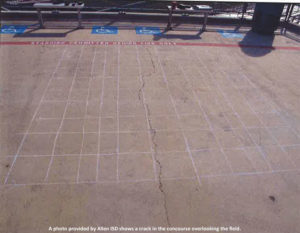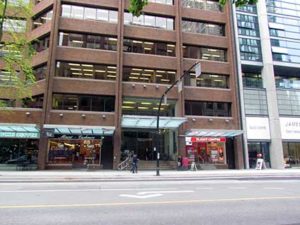Concrete Cracking at Allen High School's Stadium
Understanding Concrete Cracking: Types, Causes, and Solutions Concrete is known for its excellent compressive strength but struggles with low tensile strength, making cracking a frequent issue. This problem can arise from multiple factors like shrinkage, temperature changes, ground settling, and external stresses. These cracks vary in type and appearance; the most common include shrinkage and temperature-induced cracks, which usually run vertically or diagonally and are generally harmless unless they lead to leaks. Horizontal cracks might indicate applied loads, while wider vertical cracks at the top or bottom could suggest heaving or settlement, pointing to deeper issues involving drainage or overloading. To prevent cracking, consider using proper concrete mixes, reducing water content, and ensuring adequate cement levels. Control joints strategically placed can also help manage cracking effectively. Cracks exceeding ¼ inch in width, showing lateral displacement, leaking water, or spanning large horizontal areas often warrant attention. Case Study: Addressing Concrete Cracking at Allen High School Stadium In Allen, Texas, a newly built $60 million football stadium at a local high school encountered an unexpected issue just 18 months post-opening. The stadium’s concourse areas developed noticeable cracks, ranging from ¼ inch to ¾ inch wide, causing concerns about structural stability. Temporary measures were put in place to stop rainwater infiltration, yet the stadium remains closed until further notice, impacting the entire 2014 football season. Investigations are ongoing to determine the precise cause of the cracking. Although PBK Architects, the stadium’s designers, believe the issue isn’t design-related, Pogue Construction, the contractor, is working closely with the school district to uncover the root cause and find a resolution. It remains unclear what preventive steps were initially implemented to avoid cracking, but reinforcing the structure might be key to solving this problem effectively. HJ3’s Carbon Fiber Reinforcement System: A Sustainable Answer Concrete cracking isn’t limited to this stadium alone; it affects various structures, including walls, floors, and columns. HJ3’s Civil and Commercial reinforcement system offers a cutting-edge and eco-friendly solution that surpasses traditional repair methods or complete replacements. For instance, a commercial building owner achieved over 50% cost savings by opting for HJ3’s CarbonSeal reinforcement systems when their shear walls and concrete columns showed signs of cracking. Instead of replacing them entirely, they chose reinforcement. Success Story: Reinforcing Commercial Structures with Carbon Fiber The commercial building required seismic reinforcement for its reinforced concrete columns and shear walls. Columns measuring 12 feet and 9.1 feet needed extra reinforcement to handle shear forces in the North-South direction. The process involved cleaning the concrete surfaces, drilling holes into the columns, and applying primer. Carbon fiber dowels were inserted into the holes, smoothed on both sides, and covered with a carbon fiber-saturated layer. Shear walls were reinforced horizontally with fiberglass and vertically with carbon fiber to boost their strength. Installation was completed efficiently while the building remained operational, with HJ3 covering 12,000 square feet of concrete. This method not only saved 23,500 tons of concrete but also conserved 422,000 gallons of water, reduced CO2 emissions by 47,000 tons, and saved 6,500,000 kWh compared to replacing all the reinforced concrete columns and walls. Concrete Cracking Solutions with HJ3’s CarbonSeal By adopting HJ3’s Civil and Commercial carbon fiber reinforcement system, Allen High School’s stadium can tackle existing cracking while preventing future damage. CarbonSeal provides a cost-efficient and sustainable solution offering superior reinforcement compared to steel. Additionally, installation minimizes downtime, ensuring a seamless process. On average, clients choosing the CarbonSeal carbon fiber system save more than 50% compared to alternative repair methods. If you’re concerned about your concrete structures and are interested in HJ3’s carbon fiber reinforcement systems, contact our project managers at [insert contact details]. ††††Premium Quality Tactical Arm Defender skyshields(suzhou)thermoforming tech.co.ltd , https://www.skyshields.com
Photo Credit: NBC Washington

